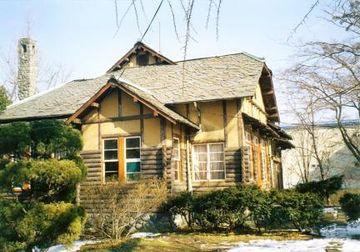이영춘 가옥
| 이영춘 가옥 Yi Yeong-chun’s House |
|
 이영춘 가옥, 국가문화유산포털, 문화재청. |
|
| 대표명칭 | 이영춘 가옥 |
|---|---|
| 영문명칭 | Yi Yeong-chun’s House |
| 한자 | 李永春 家屋 |
| 주소 | 전라북도 군산시 동개정길 7 (개정동) |
| 지정(등록) 종목 | 전라북도 유형문화재 제200호 |
| 지정(등록)일 | 2003년 10월 31일 |
| 분류 | 유적건조물/주거생활/근대주거/근대가옥 |
| 시대 | 일제강점기 |
| 수량/면적 | 1동(棟) |
| 웹사이트 | 이영춘 가옥, 국가문화유산포털, 문화재청. |
|
|
|
해설문
국문
이영춘가옥은 일제강점기 전북 지역에서 대규모 농장을 경영하였던 일본인 대지주 구마모토의 별장으로 지어졌다. 광복 후에는 구마모토 농장의 진료소장을 지냈던 이영춘(李永春, 1903∼1980) 박사가 거주하였다.
이영춘 박사는 1929년 세브란스 의전을 졸업하고 1935년 교토대학에서 의학박사 학위를 받았다. 조선인 교수 밑에서 연구한 최초의 의학박사로 농촌 보건위생의 선구자 역할을 하며, '한국의 슈바이처'로 불렸다. 병원, 학교, 영아원 등 의료 사회복지시설을 세우며 국내 처음으로 양호실을 만들었고 농민 의료보험도 도입했다.
이 가옥은 일본식 주택의 기본적인 공간 구성에 서구식 주택의 응접실과 한식 주택의 온돌방을 결합한 단층 목조 주택이다. 정교한 실내 장식과 가구뿐만 아니라, 천연 슬레이트 지붕과 자연석 및 목재로 마감한 서구식 외관이 특징적이다.
이영춘 가옥은 근대 새로운 주거 문화의 이입을 보여 주는 건축물이자, 일본인의 토지 점탈(남의 것을 강제로 빼앗아 차지함)과 이영춘 박사의 지역 의료사업을 동시에 보여 주는 근대 문화유산이다.
영문
Yi Yeong-chun’s House
This house was built around 1920 by Kumamoto Rihei (1879-1968), a Japanese landowner who ran a large plantation in the Jeollabuk-do area during the Japanese colonial period (1910-1945). After Korea regained independence in 1945, Dr. Yi Yeong-chun (1903-1980), who had served as director of the plantation’s infirmary during the colonial period, lived in this house.
Dr. Yi Yeong-chun graduated from Severance Medical College in 1929. In 1935, he received his PhD from Kyoto University. He was a pioneer in the field of rural hygiene and sanitation and for this he was called the “Schweitzer of Korea,” in reference to the Nobel Peace Prize recipient Albert Schweitzer (1875-1965). Yi established medical welfare facilities such as clinics and nurseries, created infirmaries in schools, and introduced health insurance for farmers.
This one-story wooden house has the basic layout of a Japanese house combined with a Western-style living room and Korean-style underfloor heating. The house features elaborate interior decorations and exquisite furniture, as well as a Western-style exterior featuring a slate roof and natural stone and wood finishings.
This house is an example of how a new housing culture was introduced at the beginning of the 20th century. Moreover, it also attests to the confiscation of land by the imperial Japanese and the health services provided by Dr. Yi Yeong-chun in this area.
영문 해설 내용
이 집은 일제강점기 전북 지역에서 대규모 농장을 경영하였던 일본인 대지주 구마모토 리헤이(1879-1968)의 별장으로 1920년 무렵에 지어졌다. 광복 후에는 구마모토 농장의 진료소장을 역임하였던 이영춘(1903-1980) 박사가 거주하였다.
이영춘 박사는 1929년 세브란스 의학 전문학교를 졸업하고 1935년 교토대학에서 의학박사 학위를 받았다. 농촌 보건위생의 선구자 역할을 하며, '한국의 슈바이처'로 불렸다. 병원, 영아원 등 의료 사회복지시설을 세웠으며, 학교 내에 양호실을 만들었고, 농민 의료보험도 도입했다.
단층 목조 주택으로, 일본식 주택의 기본적인 공간 구성에 서구식 주택의 응접실과 한식 주택의 온돌방이 결합되어 있다. 정교한 실내 장식과 가구 뿐만 아니라, 천연 슬레이트 지붕과 자연석 및 목재로 마감한 서구식 외관이 특징적이다.
20세기 초 새로운 주거문화의 이입을 보여주는 건축물이자, 일본인에 의한 토지 점탈과 이영춘 박사의 지역 의료사업을 동시에 보여주는 근대문화유산이다.
3D 영상
참고자료
- 이영춘, 『한국민족문화대백과사전』
- 이영춘가옥, 『디지털군산문화대전』
- 이영춘가옥, 문화재청 국가문화유산포털